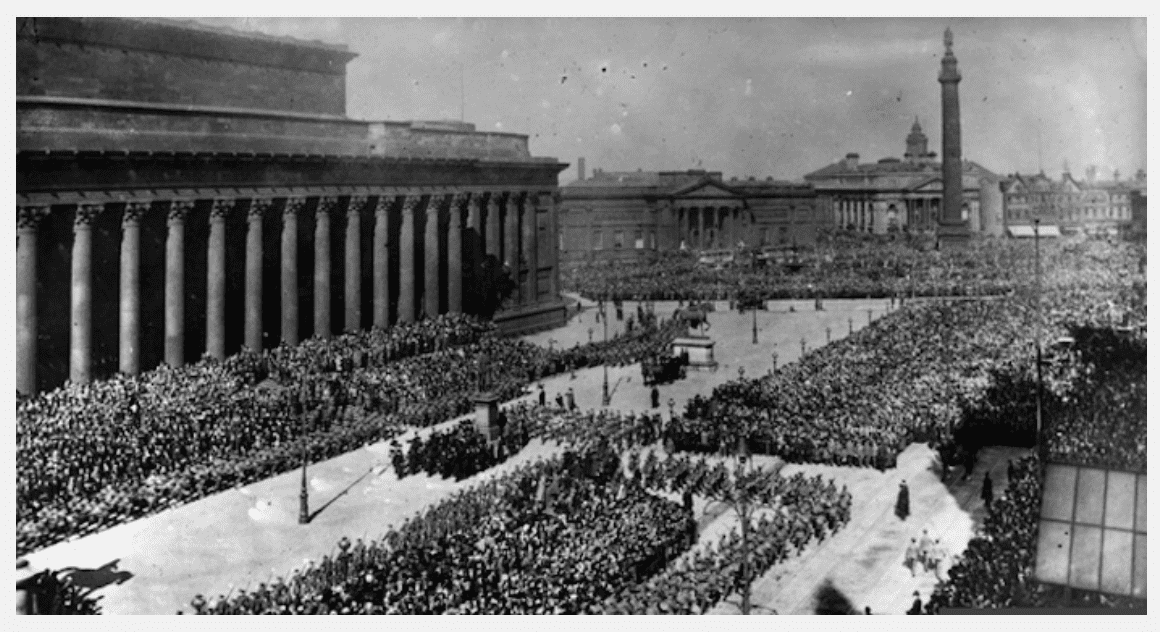Search Posts
Recent Posts
- Real Estate in RI: Seaside waterfront communities are all the rage. Who’s buying – Emilio DiSpirito June 6, 2025
- Outdoors in RI: 2A votes, Charter Yachts, active summer programs, garden tours, aquatic weeds… June 6, 2025
- All About Home Care, with two Rhode Island locations, closing after 22 years in business June 6, 2025
- GriefSPEAK: Angel wings with footprints – Mari Nardolillo Dias June 6, 2025
- Rhode Island Weather for June 6, 2025 – Jack Donnelly June 6, 2025
Categories
Subscribe!
Thanks for subscribing! Please check your email for further instructions.

Liverpool loses heritage status – David Brussat
by David Brussat, Architecture Here and There
Photo: Liverpool in 1915 as troops muster before St. George’s Hall for service in World War I. (BBC)
Seventeen years after its bestowal, Liverpool has lost its status as world heritage site by an act of Unesco, the United Nations’ chief cultural agency.
Sixteen years ago, in June 2005, I attended a symposium at RISD, which had partnered with the Royal Society for the Arts to compare efforts in Providence and Liverpool to revive the two cities. At the symposium I met Arthur Mark, a mover and shaker with ties to the RSA who lives in Rhode Island. Last night I had dinner with him, not having seen him since before his 90th birthday last year. I mentioned that I’d read that Liverpool had just lost its world heritage status. I also called to Arthur’s attention my column in the Providence Journal about the symposium, “Can civic renaissance be bottled?” He reminded me that Will Alsop, the British starchitect, had criticized me, asserting that “newspaper critics” always “oppose progress.” Alsop had no idea I was in the audience, but others did, and pointed me out as evidence in favor of Alsop’s proposition and, more generally, as the skunk at their modernist garden party.
I have reprinted my column below, and remain firm in my belief that civic renaissance can be “bottled” – if civic leaders will finally understand that civic renaissance depends on preserving architectural heritage and preserving the setting of that heritage by building new buildings – of traditional styles – that people will love. Liverpool did not heed that advice, and as a result has lost its coveted global heritage status.
***
“Can civic renaissance be bottled?”
June 9, 2005
My father studied in Liverpool for a year after he married my mother and before they had me. Beyond recalling the tedium of postwar rationing and the joy of popping over to visit the Continent, they said little to me of their stay. Still, I was very excited to learn that the Royal Society for the Arts, based since 1754 in London, and the Rhode Island School of Design were to hold a symposium comparing the birthplace of George M. Cohan (born July 3, 1878, at 536 Wickenden St.) with that of John, Paul, George and Ringo.
.
The symposium was held Sunday through Tuesday, at the RISD Auditorium, in Providence. It drew from the design and planning elite hereabouts, but also from the ranks of RSA fellows around this country.
Much grist for comparison came in the form of ambitions dashed. By the turn of the last century, Liverpool and Providence had grown rich from commerce. By 1950, however, fortune had frowned so grimly upon the head of Narragansett Bay and the mouth of the Mersey that neither city could afford — as so many others, in both countries, did — to rip down their downtowns and build anew.
So for both, poverty seeded destiny. With the beauty of Providence, readers are familiar. Liverpool likewise has truly impressive architecture. Its Three Graces — the Royal Liver Building, the Cunard Building and the Port of Liverpool Building — were erected dockside in the robust Neo-Classical styles of the early 20th Century. Block after block of Georgian, Victorian and Edwardian buildings, such as St. George’s Hall, completed in 1854, dominate the city center. Without them, no less than in Providence, renaissance would be unimaginable.
Both revivals have their critics. As always, benefits are not equally spread. In both, the gritty residue of social and cultural inequality has itself been sold as key to the authenticity of a renaissance — a quality known on both sides of the Atlantic as edginess, or edge. “Can it be bottled?” panelists from both cities asked — rhetorically, of course, as all agreed it could not.
If not, can it at least be preserved, like the old buildings that renaissance seems to require?
At most symposia, as in life, questions outnumber answers. At this symposium, answers were officially discouraged. Some answers, however — such as “Edge cannot be bottled” — were asserted repeatedly as conclusive. So was the idea that Providence needs more modern architecture, though all seemed to agree that what it had was not very good. (I.M. Pei, Philip Johnson, Edward Larrabee Barnes and Paul Rudolf have little-noted buildings here.)
The yearning for another celebrity architect to “parachute” into town was palpable. RISD President Roger Mandle, while noting that celebrity architect Rafael Moneo is doing RISD’s museum expansion, defended the “canvas” of Providence’s historic architecture, as did Rhode Island College Prof. Mark Motte. But they seemed a tiny minority.
In fact, this reporter felt like the skunk at the garden party, and was pleased to be singled out as such after celebrity architect and panelist Will Alsop, of London, observed that newspaper critics always “oppose progress” (i.e., modern architecture). Oh? In Britain maybe they do, but not in America!
Alsop himself won the competition to design Liverpool’s Fourth Grace, to join the first three alongside the Mersey docks. Alsop’s monstrosity, if built, will elbow the heck out of the three existing Graces. Blessedly, delays assure that it won’t be up by 2008. Liverpool has been designated the European Union’s “City of Culture” for that year.
I was not surprised when a Liverpudlian panelist, Eddie Berg, pointed out that while Alsop’s design had won the official competition, it came in last in a public referendum. Of course, that was nonbinding.
The importance of a public role in directing the revival of Liverpool and Providence was another of those questions whose correct answers could be assumed. But, so far as I could tell, nobody wondered why the broad public’s clear dislike of modern architecture is always so studiously ignored.
That’s because nobody wanted to hear the answer to that question. The answer, actually, is simplicity itself: For the same reason that we preserve the old buildings that people love, new buildings should be built in styles that people will love.
Why does every renaissance city have historic architecture at its base? Because that’s what people want, and that’s where people go. Build cities as people built cities for centuries, and the questions facing most cities — of sustainability, transportation, commercialism, etc. — will not be so vexing. They were not so vexing, after all, until planning and design turned edgy after World War II.
Every city a renaissance city? Bottle that answer, you royal fellows, if you dare.
_____

My freelance writing and editing on architecture and others addresses issues of design and culture locally and globally. I am a member of the board of the New England chapter of the Institute of Classical Architecture & Art, which bestowed an Arthur Ross Award on me in 2002. I work from Providence, R.I., where I live with my wife Victoria, my son Billy and our cat Gato. If you would like to employ my writing and editing to improve your work, please email me at my consultancy, dbrussat@gmail.com, or call (401) 351-0457 https://architecturehereandthere.com/
